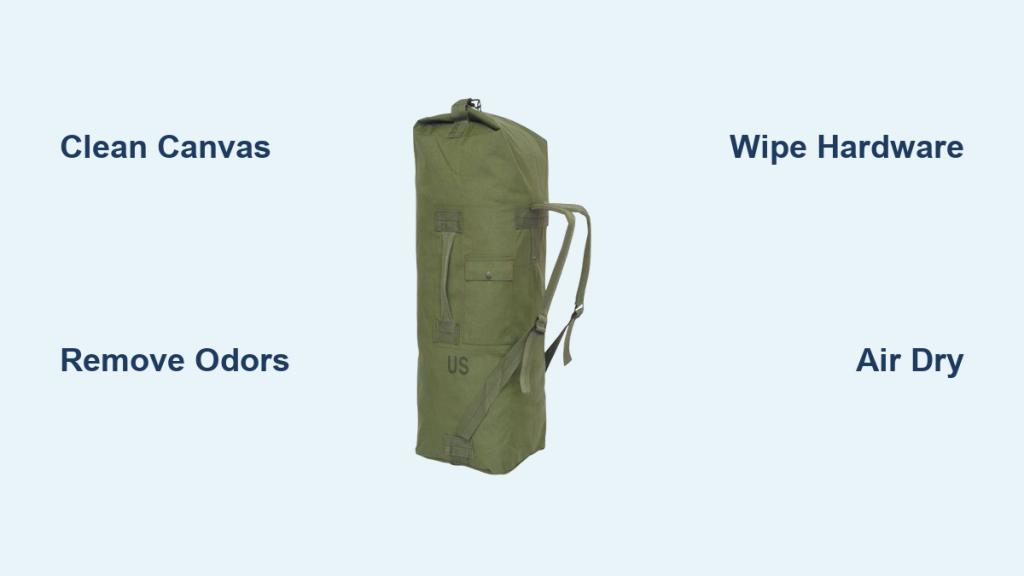Dealing with a dirty, smelly sea bag is a common frustration for military personnel and anyone who uses these durable duffels. Often, a simple wipe-down isn’t enough to tackle the grime and odors accumulated during deployments, training exercises, or just regular use. A thorough cleaning can restore your sea bag to a usable, and more pleasant-smelling, condition. This guide will walk you through a comprehensive cleaning process, from quick spot treatments to deep cleaning methods, ensuring your bag is ready for your next adventure.
This guide isn’t just about surface cleaning; we’ll cover everything from removing stubborn stains and odors to protecting the canvas and hardware for long-term durability. Whether you need a quick refresh before inspection or a full restoration after a challenging deployment, you’ll find the solutions you need to get your sea bag back into top shape. We’ll explore different cleaning methods, preventative measures, and pro tips to ensure your bag remains a reliable companion for years to come.
Understanding Your Military Sea Bag Material
Before diving into cleaning, it’s essential to understand the material of your sea bag. Most military-issued sea bags are made from heavy-duty, waxed canvas. This material is durable and water-resistant but requires specific cleaning methods to avoid damage.
- Waxed Canvas: The wax coating provides water resistance, but can be stripped away by harsh chemicals or excessive scrubbing.
- Webbing & Hardware: Straps, buckles, and zippers require separate care to prevent rust or deterioration.
- Lining (if applicable): Some bags have a nylon lining that may require gentler cleaning.
Materials You’ll Need
- Soft-bristled brush (toothbrush, nail brush, or dedicated canvas brush)
- Mild dish soap (Dawn recommended)
- Bucket or large tub
- Clean water
- Sponge or cloth
- Canvas protectant (optional, for re-waxing)
- Leather conditioner (for leather straps, if applicable)
- Old towels for drying
- Vacuum with brush attachment (optional)
Step-by-Step Cleaning Process

Phase 1: Initial Preparation
- Empty the Bag: Remove all contents from the sea bag. Check pockets and seams for any forgotten items.
- Dry Brush: Use a soft-bristled brush to remove loose dirt, dust, and debris from both the interior and exterior of the bag. Pay attention to seams and folds where dirt accumulates.
- Vacuum (Optional): Use a vacuum cleaner with a brush attachment to thoroughly remove any remaining loose particles.
Phase 2: Spot Cleaning
- Identify Stains: Examine the bag for specific stains (oil, grease, mud, etc.).
- Mild Soap Solution: Mix a small amount of mild dish soap with warm water.
- Apply & Scrub: Dip a sponge or cloth into the solution and gently scrub the stained area. Avoid excessive scrubbing, which can damage the canvas.
- Rinse: Use a clean, damp cloth to rinse away the soap residue.
Phase 3: Deep Cleaning

- Fill the Tub: Fill a bucket or large tub with lukewarm water and a generous squirt of mild dish soap.
- Submerge (If Possible): If your sea bag is small enough, submerge it completely in the soapy water. Otherwise, use a sponge and soapy water to thoroughly wet the entire exterior surface.
- Gentle Scrubbing: Use a soft-bristled brush to scrub the canvas, paying attention to areas with heavy soiling. Work in circular motions. Avoid harsh scrubbing!
- Rinse Thoroughly: Rinse the bag thoroughly with clean water to remove all soap residue. Repeat rinsing as needed. Ensure no soap remains in seams or folds.
- Hardware Cleaning: Use a separate damp cloth to wipe down all metal hardware (buckles, zippers, D-rings). For stubborn rust, use a rust remover specifically designed for metal (test in an inconspicuous area first).
Phase 4: Drying & Conditioning
- Air Dry: Allow the sea bag to air dry completely. Do not use a dryer, as heat can damage the canvas and wax coating. Hang the bag in a well-ventilated area away from direct sunlight.
- Shape Retention: While drying, stuff the bag with clean towels or crumpled newspaper to help it retain its shape.
- Canvas Protectant (Optional): Once completely dry, consider applying a canvas protectant or re-waxing the bag to restore water resistance and protect the fabric. Follow the product instructions carefully.
- Leather Conditioning (If Applicable): If your bag has leather straps, apply a leather conditioner to keep them supple and prevent cracking.
How to Remove Stubborn Odors
Military sea bags are notorious for retaining odors. Here are a few methods to combat them:
- Baking Soda: Sprinkle a generous amount of baking soda inside the bag, let it sit for 24-48 hours, then vacuum it out.
- Vinegar Solution: Mix equal parts white vinegar and water in a spray bottle. Lightly mist the interior of the bag (avoid saturating the canvas). Allow it to air dry completely. The vinegar smell will dissipate.
- Ozone Treatment: (Professional) Consider professional ozone treatment for extremely persistent odors. This is best left to specialists.
- Sunlight: Exposure to direct sunlight can help kill odor-causing bacteria.
Pro Tips for Sea Bag Cleaning and Maintenance

- Preventative Measures: Regularly brush off dirt and debris after each use.
- Avoid Harsh Chemicals: Never use bleach, strong detergents, or abrasive cleaners on waxed canvas.
- Waxing/Protecting: Re-wax your bag every 6-12 months, or as needed, to maintain water resistance.
- Zippers: Lubricate zippers with a silicone-based lubricant to prevent sticking and corrosion.
- Storage: Store your sea bag in a cool, dry place when not in use.
- Immediate Spot Treatment: Address stains as soon as possible to prevent them from setting.
When to Seek Professional Cleaning
- Extensive Damage: If the canvas is torn or severely damaged, consider professional repair.
- Stubborn Stains: If you’ve tried multiple cleaning methods and stains persist.
- Persistent Odors: If odors are overwhelming and cannot be removed with DIY methods.
FAQ
Q: Can I put my sea bag in the washing machine?
A: No, do not put your sea bag in the washing machine. The agitation and heat can damage the canvas and wax coating.
Q: What’s the best way to clean the inside of the bag?
A: Use a mild soap solution and a sponge or cloth. Baking soda is also effective for absorbing odors.
Q: How often should I clean my sea bag?
A: Clean your sea bag whenever it becomes visibly dirty or develops an unpleasant odor. A thorough cleaning 1-2 times per year is recommended.
Q: Can I use a pressure washer?
A: No. A pressure washer will damage the canvas.
Keep Your Sea Bag Ready for Duty
By following these steps, you can effectively clean and maintain your military sea bag, ensuring it remains a reliable and durable companion for years to come. A little preventative care and regular cleaning will keep your bag in top condition, ready for whatever challenges lie ahead.
Have you successfully cleaned your sea bag using these methods? Share your experiences and tips in the comments below to help other readers!




